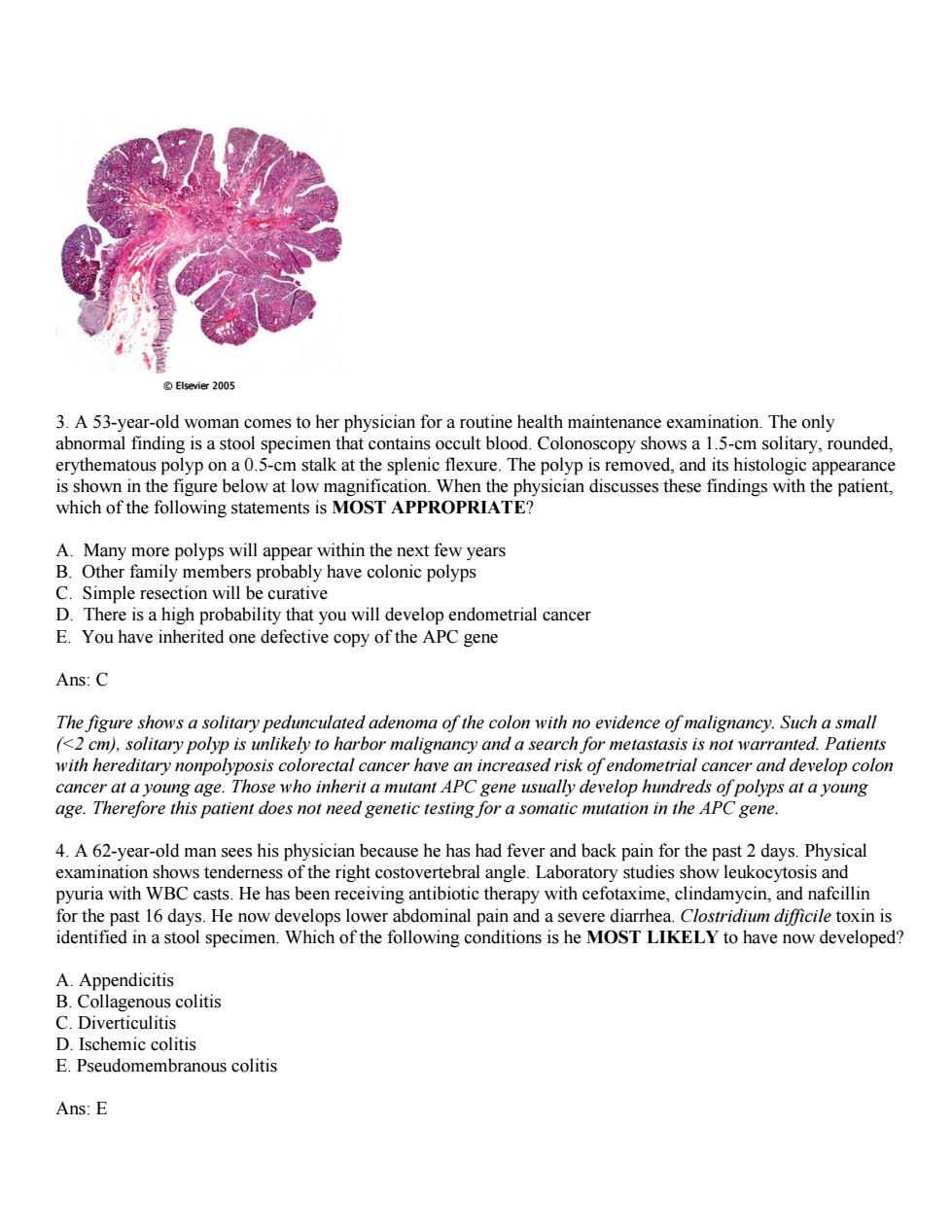正在加载图片...

Elsevier 2005 3.A 53-year-old woman comes to her physician for a routine health maintenance examination.The only abnormal finding is a stool specimen that contains occult blood.Colonoscopy shows a 1.5-cm solitary,rounded, polyp on a05cm stalk at the splensician disc is sho in the fi e below at lo nification.When the phy these findings v e patient. which of the follo B ny more polyps will appe within the next few years Other fa s probably have colonic polyps be curative There is a high probability that you will develop endometrial cancer E.You have inherited one defective copy of the APC gene Ans:C The figure shows a solitary pedunculated adenoma of the colon with no evidence of malignancy.Such a small (<2 cm),solitary polyp is unlikely to harbor malignancy and a search for metastasis is not warranted.Patients with hereditary nonpolyposis colorectal cancer have an increased risk of endometrial cancer and develop colon cancer at a young age.Those who inherit a mutant APC gene usually develop hundreds of polyps at a young age.Therefore this patient does not need genetic testing for a somatic mutation in the APCgene 4 a 62-vear-old man sees his physician because he has had fever and back pain for the past 2 days physical examination shows tenderness of the right costovertebral angle.Laboratory studies show leukocytosis and inal pa a sever n a sto lowngonishe MOSIKELYto have o deveoped E.Pseudomembranous colitis Ans:E 3. A 53-year-old woman comes to her physician for a routine health maintenance examination. The only abnormal finding is a stool specimen that contains occult blood. Colonoscopy shows a 1.5-cm solitary, rounded, erythematous polyp on a 0.5-cm stalk at the splenic flexure. The polyp is removed, and its histologic appearance is shown in the figure below at low magnification. When the physician discusses these findings with the patient, which of the following statements is MOST APPROPRIATE? A. Many more polyps will appear within the next few years B. Other family members probably have colonic polyps C. Simple resection will be curative D. There is a high probability that you will develop endometrial cancer E. You have inherited one defective copy of the APC gene Ans: C The figure shows a solitary pedunculated adenoma of the colon with no evidence of malignancy. Such a small (<2 cm), solitary polyp is unlikely to harbor malignancy and a search for metastasis is not warranted. Patients with hereditary nonpolyposis colorectal cancer have an increased risk of endometrial cancer and develop colon cancer at a young age. Those who inherit a mutant APC gene usually develop hundreds of polyps at a young age. Therefore this patient does not need genetic testing for a somatic mutation in the APC gene. 4. A 62-year-old man sees his physician because he has had fever and back pain for the past 2 days. Physical examination shows tenderness of the right costovertebral angle. Laboratory studies show leukocytosis and pyuria with WBC casts. He has been receiving antibiotic therapy with cefotaxime, clindamycin, and nafcillin for the past 16 days. He now develops lower abdominal pain and a severe diarrhea. Clostridium difficile toxin is identified in a stool specimen. Which of the following conditions is he MOST LIKELY to have now developed? A. Appendicitis B. Collagenous colitis C. Diverticulitis D. Ischemic colitis E. Pseudomembranous colitis Ans: E